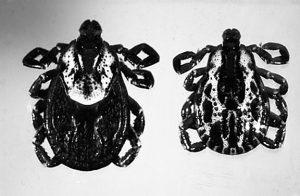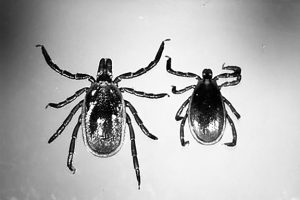Take precautions to avoid tick bites
Published on May 27, 2022 at 10:50am CDT
Growing Green
By Robin Trott, Extension Educator
Last night I found an engorged wood tick on my little kitty, Raven. Hard to believe that we went from winter to tick season so fast! As you begin to
spend more time outdoors, here is some information to identify ticks and guard against tick bites.
The two most common ticks in Minnesota are the American dog tick, Dermacenter variablis, or wood tick, and the Blacklegged tick, Ixodes variablis (formerly known as deer tick), which carries Lyme disease and other diseases.

American dog ticks.
American dog tick (wood tick)
• Unfed adults are dark brown with whitish or yellowish markings.
• On females these markings cover half of the body and, on males, nearly the entire body.
• These marking will be difficult to see on engorged ticks and are not present on immature ticks.
Blacklegged tick (formerly deer tick)
• Adult female blacklegged ticks are reddish brown with a black head, legs and scutum.
• Unfed adults don’t have any
• The presence or absence of marking will be difficult to see on engorged and immature ticks.
• A blacklegged tick can only transmit disease to humans through a bite. They can’t do so by just crawling on a person. Even when biting, a blacklegged tick must stay attached for at least 24 to 48 hours to transmit Lyme disease (12 to 24 hours to transmit human anaplasmosis).
The American dog tick in Minnesota can carry Rocky Mountain spotted fever, though this is rare. For more information on Rocky Mountain spotted fever, see information at the Centers for Disease Control and Prevention (CDC). The blacklegged tick carries Lyme disease and several other diseases. See the Minnesota Department of Health page on tickborne diseases.
High risk areas for tick exposure in Minnesota include the north central, east-central and southeastern regions of the state, also extending into some northwestern counties. Greatest risk is found within hardwood or mixed hardwood forests, which provide suitable habitat for blacklegged ticks.
Risk of bites from these ticks in Minnesota is highest during the spring, early summer and fall months. Tickborne diseases have been increasing each year in the state.
If you want to find out for sure what type of tick you’ve found, you can fill out a form at: www.health.state.mn.us/diseases/tickborne/monitoring.html and send it and the tick to the health department for proper identification. This helps the state monitor where ticks are active.

To avoid tick bites:
• When in the woods, walk on trails and avoid moving through grassy areas.
• Wear protective clothing, such as long-sleeved shirts and pants that are light-colored.
• Use repellents like DEET or permethrin.
• Always follow instructions and read warnings on repellent labels.
Until next time, happy gardening!
* * * * * * * * * * * * *
In summer the empire of insects spreads. ~Adam Zagajewski




